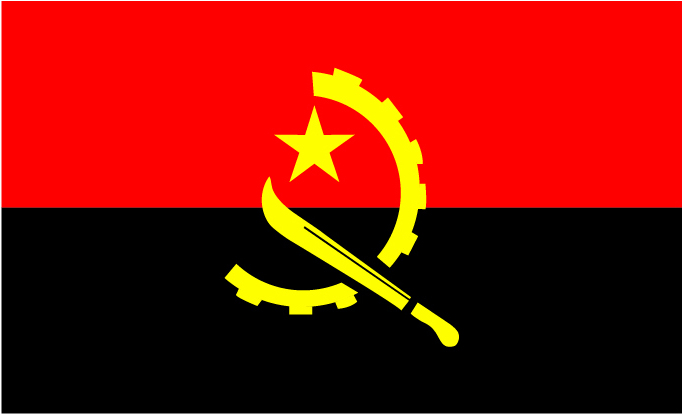Angola

| Government | |
| Name | Republic of Angola |
| Portuguese | República de Angola |
| Government type | Presidential republic |
| Capital | Luanda (2,571,861 (2019)) |
| Currency | Kwanze (AOA) |
| People | |
| Population (2020) | 32,866,268 (46th) |
| Density of population | 24.97 P/km2 (199th) |
| Nationality | Angolan |
| Official languages | |
| Portuguese | |
| Ethnic groups | |
| Ovimbundu | 37% |
| Kimbundu | 25% |
| Bakongo | 13% |
| mestico (mixed European and native African) | 2% |
| European | 1% |
| Other | 22% |
| Religion | |
| Roman Catholic | 41.1% |
| Protestant | 38.1% |
| Other | 8.6% |
| None | 12.3% |
| Life expectancy (2020) | |
| Male | 59.3 years |
| Female | 63.4 years |
| Total population | 61.3 years (213th) |
| Homicides | |
| Total (2012) | 4.8 per 100,000 people (66th) |
| Literacy (2015) | |
| Definition: age 15 and over can read and write | |
| Male | 82% |
| Female | 60.7% |
| Total population | 71.1% |
| Geography | |
| Land area | 1,246,700 km2 |
| water area | 0 km2 |
| total area | 1,246,700 km2 (24 th) |
| Mean elevation | 1,112 m |
| Lowest point | |
| Atlantic Ocean | 0 m |
| Highest point | |
| Moca | 2,620 m |
| Land use (2016) | |
| Agricultural land | 47.5% |
| Arable land | 3.9% |
| Permanent crops | 0.3% |
| Permanent pasture | 43.3% |
| Forest | 46.3% |
| Other | 6.2% |
| Urbanization | |
| Urban population (2020) | 66.8% |
| Rate of urbanization | 4.32% annual rate of change (2015 – 2020) |
| Economy | |
| Labor force (2017) | 12.51 million (46th) |
| Agriculture | 85% |
| Industry and service | 15% |
| Unemployment rate (2016) | 6.6% (97th) |
| GDP (PPP) (estimate 2019) | |
| GDP (PPP) (estimate 2019) | |
| Total | $208.034 billion (64th) |
| Per capita | $6,850 (107th) |
| GDP (nominal) (estimate 2019) | |
| Total | $124.600 billion (61st) |
| Per capita | $4,101 (91st) |
| GDP by sector (estimate 2011) | |
| Agriculture | 10.2% |
| Industry | 61.4% |
| Services | 28.4% |
| Exports (2017) | $33.07 million (59th) |
| Exports partners (2017) | |
| China | 61.2% |
| India | 13% |
| US | 4.2% |
| Imports (2017) | $19.5 billion (77th) |
| Imports partners (2017) | |
| Portugal | 17.8% |
| China | 13.5% |
| US | 7.4% |
| South Africa | 6.2% |
| Brazil | 6.1% |
| UK | 4% |
Angola on the world map

States and political map of Angola

Angola is located in Southern Africa. It is bordered by the Atlantic Ocean to the west, The Republic of the Congo to the north, The Democratic Republic of the Congo to the north and to the north east, Zambia to the east and Namibia to the south.
Angola has an exclave province, the province of Cabinda, that borders the Republic of the Congo and the Democratic Republic of the Congo.
Angola has 18 provinces (provincias – provincia in singular): Bengo, Benguela, Bié, Cabinda, Cuando Cubango, Cuanza Norte, Cuanza Sul, Cunene, Huambo, Huíla, Luanda, Lunda Norte, Lunda Norte, Luanda Sul, Malanje, Moxico, Namibie, Uíge and Zaire.
Physical map of Angola

Cities, airports, ports, railroads, ferries and road map of Angola

Angola top 10 largest cities (2014)
- Luanda (6,759, 313)
- Lubango (600,751)
- Huambo (595,304)
- Benguela (555,124)
- Cabinda (550,000)
- Malanje (455,000)
- Saurimo (393,000)
- Lobito (357,950)
- Cuíto (355,423)
- Uíge (322,531)
Demography
Population pyramid

Age structure
Estimate for 2020:
- 0-14 years: 47.83% (male 7,758,636/female 7,797,869)
- 15-24 years: 18.64% (male 2,950,999/female 3,109,741)
- 25-54 years: 27.8% (male 4,301,618/female 4,740,463)
- 55-64 years: 3.43% (male 523,517/female 591,249)
- 65 years and over: 2.3% (male 312,197/female 436,050)
Remark: the age structure of a population affects a nation’s key socioeconomic issues. Countries with young populations (high percentage under age 15) need to invest more in schools, while countries with older populations (high percentage ages 65 and over) need to invest more in the health sector. The age structure can also be used to help predict potential political issues. For example, the rapid growth of a young adult population unable to find employment can lead to unrest.
Population from 1950 to 2020
Source: United Nations, Department of Economic and Social Affairs, Population Division (2019). World Population Prospects 2019, Online Edition. Rev. 1.
Evolution of the life expectancy from 1960 to 2018
Source: World Development Indicators, The World Bank
Major river
- Zambezi (2,575 km / 1,600 mi)
Economy
Agriculture:
bananas, sugarcane, coffee, sisal, corn, cotton, cassava (manioc, tapioca), tobacco, vegetables, plantains, livestock, forest products, fish
Industries:
petroleum, diamonds, iron ore, phosphates, feldspar, bauxite, uranium, and gold, cement; basic metal products, fish processing, food processing, brewing, tobacco products, sugar, textiles, ship repair
Exports – commodities:
crude oil, diamonds, refined petroleum products, coffee, sisal, fish and fish products, timber, cotton
Imports – commodities:
machinery and electrical equipment, vehicles and spare parts; medicines, food, textiles, military goods
Time in Angola
Go to our interactive map to get the current time in Angola